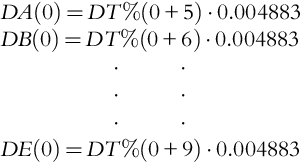Sampling Techniques
There are two sampling techniques:
• series (sequential) sampling with interpolation, and
• parallel sampling with holding network [79, Chapter 2].
Series Sampling with Interpolation
The derating measurements as described in Section 2.8 are based on sequential sampling utilizing the soft- and hardware specified by the UCDAS-16G Manual of the Keithley Corporation [80, Chapter 2]. The software program is written in Quick BASIC language. Sampling programs for two and five channels have been used [81, Chapter 2]. Some of the frequently asked questions concerning sequential sampling are addressed as follows.
1.1 What criterion is used to select the sampling rate (see line 500 of two-channel program [81, chapter 2])?
The A/D converter UCDAS-16G has a maximum throughput (sampling) rate of 70 kHz in the direct memory access (DMA) mode, where the gain is 1.0.
In the Two-Channel Program [81, Chapter 2]
select
from this follows the SAMPLE RATE
In the Five-Channel Program [81, Chapter 2]
select
from this follows the SAMPLE RATE
1.2 What criterion is used to select the total number of conversions (line 850 of the two-channel program [81, chapter 2])?
In the Two-Channel Program
One period T = 16.66 ms of fundamental frequency (f = 60 Hz) signal is approximated by 360 equidistant intervals or 360 + 1 = 361 points as indicated in Fig. A1.1. For two channels and sequential sampling 361 · 2 = 722 sample points are required. Due to interpolation procedure #1 at the end of the sampled period (discussed later), one chooses a somewhat larger number 722 + 11 = 733.

In the Five-Channel Program
One period T = 16.66 ms of fundamental frequency (f = 60 Hz) signal is approximated by 180 equidistant intervals or 180 + 1 = 181 points as explained in Fig. A1.2. For five channels and sequential sampling 181 · 5 = 905 sample points are required. Due to interpolation one chooses a somewhat larger number 905 + 9 = 914.

1.3 Why are the two-channel program dimension and the array for the channel number not used for the five-channel program [81, chapter 2]?
There are two ways to store the data:
• For the two-channel program, the array DT%(N) comprises the sampled points of both (2) channels (e.g., in an interleaved manner). Therefore, CH%(N) is needed to separate the sample points for each channel, and DT%(N) results in DA(N + 10) (increased due to interpolation).
• For the five-channel program, the array DA(368) contains the sample points of channel #1, DB(368) contains the sample points of channel #2, etc. That is, the sampled data are separated for each channel and no channel number CH%(N) is required.
1.4 What is the criterion for selecting the multiplying factor in step 9 (0.004882812 ≈ 0.004883) for the two- and five-channel configurations?
The UCDAS-16G is a 12 bit converter, that is, ± 10 V is divided into 212 = 4096 steps. For a voltage peak-to-peak value of 10 V - (-10 V) = 20 V one step corresponds to 20 V/4096 = 0.004882812 V ≈ 0.004883 V.
1.5 Why is in step 9 of the two-channel program (line 1254) the array either DA(n + 10) or DA(733), and in the five-channel program (line 1233) the array is DA(368)?
For the two-channel program the sampled data of both channels are stored in DA(733) as indicated in Fig. A1.3. For the five-channel program the sampled data are stored separately for each channel, that is, for channel #1 in DA, for channel #2 in DB, etc. explained in Fig. A1.4.


For I = 0 (line 1235):
For I = 2 (line 1235):
For I = 4:
One concludes that although there are only 181 sampled points for each channel of the five-channel program, the Fourier program [81, Chapter 2] requires 181 · 2 = 362 or 362 + 6 = 368 dimensions for array DA, that is, DA(368). The points between sampled points are obtained by interpolation procedure #2. Lines 1241 to 1247 of the five-channel program perform this interpolation. The sequential sampling does not provide at a given instant of time values for all five channels; therefore, at each instant of time a channel signal datum is generated by interpolation procedure #2 for each and every sampled function. The interpolation procedure is explained in Figs. A1.5 and A1.6.


For J = 0:
where (1/5) is the weighting function for DB(0)OLD and (4/5) is the weighting function for DB(2)OLD.
Statements (line 1248 to line 1257) restore the data because FORTRAN cannot handle DA(0), that is, DA(0) becomes DA(1), etc.







